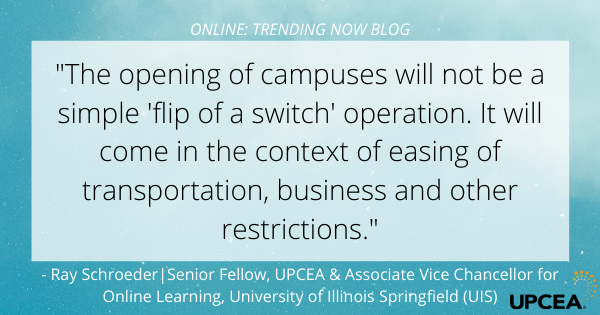Planning for Mode of Course Delivery in Summer and Fall
As many of us are still grappling with the daily details of remote delivery of campus classes, we must turn our eyes to the summer and fall.
Many of us have been working day and night to launch our campuswide remote learning response to the virus. Exhausting as that is, we should carve out some time to look ahead. Will this continue through the summer? Will it spill over into the fall? How will we respond? How should we plan?
At this point, the answers are still up in the air. The virus has not yet hit a peak in most states and communities in the U.S. Certainly, we will not want to reopen campuses until we are well past the peak number of cases — and state governors will likely make those decisions for us on a state-by-state basis. When they will come and how they will be implemented, no doubt, will include different scale-down stipulations.
Models are emerging on the future of the virus in the coming months. Lives and careers hang in the balance: Science magazine looks at some predictions. This MIT Technology Review article suggests an 18-month model by Imperial College (also referenced in the Science article). The model shows “aftershocks” of smaller, but significant, peaks in infections every three to four months for the next year and a half.
Lest we forget, more than half of the confirmed cases with the virus in South Korea are younger than 50 years old, and in the U.S., nearly 40 percent are younger than 55.
These are not trivial infections. Many of those who require hospitalization can expect long-term lung damage. To better understand the danger and potential damage, this sobering article includes a George Washington University Hospital video of what this virus can do to the lungs of someone younger than 60.
The opening of campuses will not be a simple “flip of a switch” operation. It will come in the context of easing of transportation, business and other restrictions. The Brookings Institution, in assessing how openings might take place, notes for campuses:
Medical centers, hospitals, and universities are on the front lines of the battle against COVID-19, and many are already overtaxed. With dormitories, dining halls, and large groups of people, they will be highly vulnerable to the secondary waves of contagion. How can we ensure that they can operate safely to carry out vital research during pandemics? Just as with other large-scale civic assets, classes in these institutions can be kept small, but institutions will need to retrofit dormitories and dining halls with temperature checks and ensure adequate social distancing so they can safely function.
So, what is our path forward? It is unlikely that we will be able to fully open our campuses by June. Fortunately for many universities, the summer session is already heavily populated with online classes. In some respects, we are better prepared to meet the reduced summer load than we are the fall or spring. The summer classes that have previously been taught online are a step above the emergency patchwork of remote teaching solutions we put in place this semester. The existing online classes have gone through pedagogy, outcomes, technology and best-practices checks that we simply could not complete in the week or two we had earlier this term.
 What if campus closures or periodic closures continue into the fall? Will we open the campus with the expectation that an aftershock bump in infections will occur? In doing so we would risk infection hot spots at our campuses. Internal and external pressure could well force closings on a short notice as soon as new cases are exposed. Conservative risk-management practices would suggest that we plan for an online fall semester. By the end of the year, we can be hopeful that viable treatments will be found. A vaccine is still probably 18 months away, but the race is on to find drugs and therapies that will treat those who contract the disease. The World Health Organization is sponsoring a massive collaborative effort titled SOLIDARITY that marshals worldwide efforts to find effective treatments.
What if campus closures or periodic closures continue into the fall? Will we open the campus with the expectation that an aftershock bump in infections will occur? In doing so we would risk infection hot spots at our campuses. Internal and external pressure could well force closings on a short notice as soon as new cases are exposed. Conservative risk-management practices would suggest that we plan for an online fall semester. By the end of the year, we can be hopeful that viable treatments will be found. A vaccine is still probably 18 months away, but the race is on to find drugs and therapies that will treat those who contract the disease. The World Health Organization is sponsoring a massive collaborative effort titled SOLIDARITY that marshals worldwide efforts to find effective treatments.
Even when we are able to extinguish the threat of this virus, the anxiety may continue. That anxiety may create a push for a higher percentage of blended and online classes to hedge against continuing or newly emerging threats. The landscape of delivery of higher education may be changed forever.
What are you planning for fall term; are you adjusting your online schedule? Are you conducting a deeper dive into those classes that were made remote delivery ready last month without a thorough development process? Are you prepared to do that thorough redevelopment this summer?
This article originally was published in Inside Higher Ed’s Transforming Teaching & Learning blog.

Ray Schroeder is Professor Emeritus, Associate Vice Chancellor for Online Learning at the University of Illinois Springfield (UIS) and Senior Fellow at UPCEA. Each year, Ray publishes and presents nationally on emerging topics in online and technology-enhanced learning. Ray’s social media publications daily reach more than 12,000 professionals. He is the inaugural recipient of the A. Frank Mayadas Online Leadership Award, recipient of the University of Illinois Distinguished Service Award, the United States Distance Learning Association Hall of Fame Award, and the American Journal of Distance Education/University of Wisconsin Wedemeyer Excellence in Distance Education Award 2016.
Other UPCEA Updates + Blogs
Whether you need benchmarking studies, or market research for a new program, UPCEA Consulting is the right choice.
We know you. We know the challenges you face and we have the solutions you need. We speak your language and have been serving leaders like you for more than 100 years. UPCEA consultants are current or former continuing and online higher education professionals who are experts in the industry—put our expertise to work for you.
UPCEA is dedicated to advancing quality online learning at the institutional level. UPCEA is uniquely focused on excellence at the highest levels – leadership, administration, strategy – applying a macro lens to the online teaching and learning enterprise. Its engaged members include the stewards of online learning at most of the leading universities in the nation.
We offers a variety of custom research options through a variable pricing model.
